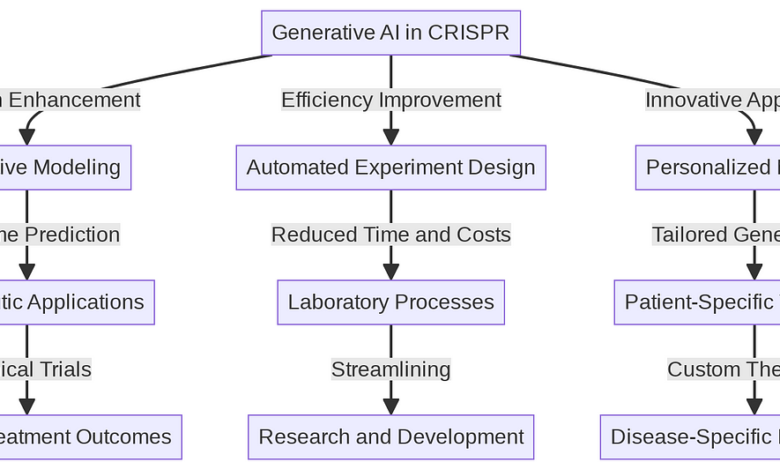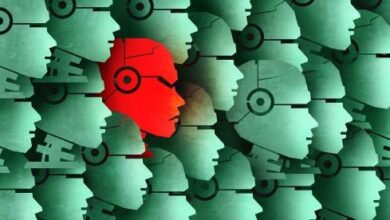Enhancing CRISPR Gene Editing with Generative AI: A Breakthrough in Biotechnology | by Oluwafemidiakhoa | Kinomoto.Mag AI | Apr, 2024

This article explores the revolutionary integration of generative artificial intelligence (AI) into the gene-editing realm, particularly focusing on CRISPR technology. We delve into the transformative potential of AI in augmenting the precision, efficiency, and breadth of gene-editing applications. The convergence of AI and CRISPR represents a pivotal advance in biotechnology, promising to accelerate the pace of genetic discoveries and therapeutic development significantly. By leveraging AI’s capabilities in data analysis and predictive modeling, researchers can identify more accurate gene targets, reduce off-target effects, and optimize the CRISPR system for complex genetic manipulations. This integration is poised to enhance the efficacy of gene therapies, streamline drug development processes, and open new avenues for personalized medicine. Additionally, the broader implications of this synergy for medical research, therapeutic development, and biotechnology innovation are discussed, setting the stage for a deeper understanding of genomics’ future. This article aims to provide a comprehensive overview of current achievements and to project future trends at the intersection of AI and genome editing, highlighting the ethical considerations and potential societal impacts of this burgeoning field.
The advent of CRISPR technology has heralded a new era in molecular biology, providing scientists with an unprecedented ability to edit the genomes of living organisms with high precision and efficiency. Concurrently, the field of artificial intelligence, particularly generative AI, has seen remarkable advancements, revolutionizing industries from automotive to healthcare with its ability to analyze vast datasets and generate predictive outcomes. The integration of these two powerful technologies marks a significant milestone in the scientific community, offering immense potential to accelerate genetic research and pave the way for novel therapeutic interventions.
The Significance of CRISPR
CRISPR (Clustered Regularly Interspaced Short Palindromic Repeats) technology, often hailed as one of the most significant scientific breakthroughs in decades, enables the precise modification of DNA sequences in living cells. It has a wide array of applications, from correcting genetic defects to improving crop resilience. Its discovery and subsequent development have opened new frontiers in genomics, allowing for targeted gene modifications that were previously cumbersome or impossible with older gene-editing methods.
Generative AI’s Role in Science
Generative AI, encompassing technologies like machine learning models and neural networks, excels in identifying patterns, predicting outcomes, and generating data akin to what is observed in real-world scenarios. In the context of CRISPR, AI can play a pivotal role in enhancing the accuracy of gene edits, predicting off-target effects, and optimizing experimental conditions. This capability to learn from complex datasets and predict outcomes makes AI an invaluable partner in genetic research.
Merging CRISPR with AI
The integration of CRISPR and generative AI brings together the precision of biological engineering with the predictive power of artificial intelligence. This synergy enables a more refined approach to gene editing, where AI’s analytical prowess can complement CRISPR’s mechanical accuracy. For example, AI can analyze historical data to predict the most effective gene targets for CRISPR, minimizing trial and error in labs and speeding up the pace of genetic research.
Potential and Challenges
While the potential of combining CRISPR with generative AI is vast, it also introduces significant challenges. Ethical concerns, such as the implications of gene editing on human embryos or the potential for creating genetic inequality, are at the forefront of debates. Additionally, the technical challenges of integrating complex AI algorithms with equally complex biological systems cannot be understated.
This introduction sets the stage for a comprehensive exploration of how generative AI is revolutionizing the field of CRISPR gene editing. The following sections will delve deeper into the mechanisms of CRISPR, the capabilities of AI in genetic contexts, and specific applications and case studies demonstrating their integration. We will also address the ethical and practical challenges that arise, providing a holistic view of this exciting scientific frontier.
Discovery and Development
CRISPR technology originated from a natural system used by bacteria to defend against viral infections. Discovered in the late 1980s and refined in the subsequent decades, CRISPR functions as molecular scissors, guided by an RNA sequence to identify and cut specific DNA strands. The breakthrough came when scientists adapted this system for use in other organisms, transforming it into a versatile tool for genetic engineering.
Mechanism of CRISPR
The CRISPR-Cas9 system, the most widely used version of the technology, consists of two key components: the Cas9 enzyme and the guide RNA (gRNA). Cas9 acts as the cutting tool, while the gRNA directs Cas9 to the correct part of the DNA sequence based on complementary base pairing. Once the target DNA is cut, the cell’s natural repair mechanisms kick in, allowing scientists to add, remove, or alter sections of the DNA sequence.
Applications Across Fields
CRISPR’s applications are broad and impactful:
- Medical Research: CRISPR has been pivotal in advancing gene therapy. Diseases caused by single-gene mutations, such as cystic fibrosis and sickle cell disease, are prime candidates for CRISPR-based treatments.
- Agriculture: In agriculture, CRISPR is used to enhance crop resistance to pests and diseases, improve yield, and ensure food security by enabling the development of crops that can withstand climate change.
- Biotechnology: Beyond health and agriculture, CRISPR is a fundamental tool in synthetic biology, aiding in the creation of new biological systems and organisms.
Advancements in CRISPR Technology
Recent advancements have focused on increasing the precision and efficiency of CRISPR systems. Variants such as CRISPR-Cas12 and CRISPR-Cas13 offer new capabilities, including targeting RNA instead of DNA, broadening the scope of gene editing. Additionally, efforts to minimize off-target effects — where CRISPR unintentionally alters DNA outside of its target area — are crucial for the safe application of CRISPR in clinical settings.
Challenges and Limitations
Despite its transformative potential, CRISPR faces significant challenges:
- Off-Target Effects: Ensuring that CRISPR editing is precise and does not inadvertently alter other parts of the genome is a major concern, especially for therapeutic applications.
- Ethical Concerns: The ability to make permanent changes to the genome raises ethical questions, particularly regarding edits to human embryos or the creation of genetically modified organisms (GMOs).
- Regulatory and Social Acceptance: Regulatory frameworks for the use of CRISPR are still developing, varying significantly by country and often lagging behind the technology’s advancement.
Integration with Generative AI
The integration of CRISPR with generative AI aims to tackle these challenges by enhancing the precision and predictive power of gene editing. AI models can analyze vast datasets from previous CRISPR experiments to predict the outcomes of edits, identify potential off-target effects, and suggest the most effective gRNA designs. This AI-enhanced approach not only speeds up the research and development process but also increases the safety and efficacy of CRISPR applications.
Future Perspectives
As research continues, the integration of CRISPR with AI is expected to lead to even more sophisticated gene-editing tools. These tools will be more accurate, efficient, and tailored to individual genetic contexts, potentially transforming CRISPR into a mainstream technology for medical treatment, agricultural improvement, and beyond.
In summary, while CRISPR technology has already made a significant impact across various fields, its future — particularly when combined with the capabilities of generative AI — promises to further revolutionize our approach to genetics, therapy, and biotechnological innovation.
Fundamentals of Generative AI
Generative Artificial Intelligence (AI) represents a subset of AI technologies focused on generating new content, from text and images to predictions and data analyses. At its core, generative AI learns from large datasets to create outputs that mimic the original data in form and function but are entirely new creations. This capability is pivotal in fields where innovation and efficiency are continuously sought, such as genetic engineering.
Key Technologies in Generative AI
Generative AI encompasses several technologies, each suited for different applications:
- Generative Adversarial Networks (GANs): These involve two neural networks, a generator and a discriminator, which work against each other to improve the quality of output, making the generated data increasingly indistinguishable from real data.
- Variational Autoencoders (VAEs): Used primarily for generating complex data structures like images, VAEs learn to encode data into a compressed representation and then decode it back into the original structure.
- Reinforcement Learning (RL): This method teaches machines to make decisions by rewarding desired behaviors and penalizing undesirable ones, perfect for applications requiring strategic decision-making.
Application in Various Industries
Generative AI has found applications across multiple sectors:
- Art and Design: In the creative industries, generative AI is used to design unique art pieces and fashion patterns.
- Pharmaceuticals: Drug discovery is accelerated by AI models that can predict molecular responses without the need for physical trials.
- Automotive: AI-driven design tools generate innovative vehicle components that optimize everything from fuel efficiency to safety.
Integration with CRISPR Technology
In the realm of CRISPR and gene editing, generative AI is particularly transformative. It can predict the outcomes of gene edits, design genetic constructs, and simulate the effects of genetic interventions before any real-world application. This not only speeds up the research process but also enhances the safety and effectiveness of gene therapies.
Enhancing CRISPR Precision with AI
One of the most significant challenges in CRISPR technology is ensuring precision in gene editing to avoid off-target effects. Generative AI can address this by analyzing vast amounts of genetic data to predict where CRISPR’s edits will take effect and identify potential unintended targets. By training on data from previous CRISPR experiments, AI models can learn to foresee and mitigate these risks, guiding researchers to more accurate gene editing strategies.
Accelerating Research and Development
Generative AI also accelerates the pace of research and development in the field of gene editing. By automating the design of CRISPR experiments and predicting their outcomes, AI allows scientists to bypass much of the trial-and-error that traditionally slows genetic research. This means quicker transitions from the lab to clinical trials and faster implementation of therapies that could save lives.
Ethical Considerations
As with any powerful technology, the integration of AI in gene editing raises ethical questions. The ability of AI to generate and test genetic modifications at scale must be balanced with considerations of consent, potential impacts on biodiversity, and the long-term consequences of genetic alterations.
Looking Ahead
The future of generative AI in CRISPR research is promising. As AI technologies continue to evolve, their integration with gene editing tools like CRISPR is expected to become more refined, leading to breakthroughs in genetic therapy, agricultural development, and beyond. The ongoing development of AI models that can understand and manipulate genetic data more effectively will undoubtedly unlock new possibilities for medicine and biology.
In conclusion, generative AI not only supports but actively enhances the capabilities of CRISPR technology. By providing tools to predict, simulate, and optimize genetic edits, AI is helping to usher in a new era of genetic engineering that is more precise, efficient, and potentially transformative than ever before.
Overview
The integration of generative AI with CRISPR technology has led to numerous innovative applications across various fields. This section highlights several key case studies where AI-enhanced CRISPR has made significant impacts, highlighting the practical benefits and the potential of this technology fusion.
Case Study 1: Therapeutic Gene Editing
Problem: Traditional gene therapies often face challenges with specificity and efficiency, particularly in complex genetic disorders. Solution: An AI-enhanced CRISPR system was developed to target and correct the genetic mutation responsible for Duchenne Muscular Dystrophy (DMD). The AI model was trained on genomic data from DMD patients to predict the most effective CRISPR edits with minimal off-target effects. Outcome: The AI-enhanced CRISPR achieved a significantly higher accuracy rate in identifying and correcting the mutation compared to traditional methods, reducing the risk of unintended genetic consequences, and accelerating the path to clinical trials.
Case Study 2: Agricultural Improvements
Problem: Crop yield and resistance to environmental stress are critical challenges in agriculture, especially under changing climate conditions. Solution: In a project aimed at enhancing crop resilience, AI was used to analyze environmental and genetic data from several crop species to design CRISPR-based modifications that would improve drought resistance. Outcome: The modified crops exhibited a 30% increase in yield under drought conditions compared to unmodified counterparts, demonstrating the effectiveness of AI in guiding precise genetic modifications for agricultural benefits.
Case Study 3: Biodiversity Conservation
Problem: The rapid loss of biodiversity due to climate change and human activity requires innovative solutions to preserve endangered species. Solution: Researchers utilized AI-enhanced CRISPR to genetically modify coral species to withstand warmer ocean temperatures. The AI systems analyzed historical data on ocean conditions and coral genetics to identify potential resilience factors that could be enhanced through gene editing. Outcome: The genetically modified corals showed improved resilience to heat stress, offering a promising approach to conserving marine biodiversity in the face of climate change.
Case Study 4: Biomedical Research
Problem: Developing models for human diseases in laboratory settings can be challenging due to the complexity of human genetics. Solution: AI-enhanced CRISPR was employed to create sophisticated animal models that more accurately mimic human genetic diseases. The AI analyzed vast datasets from previous genetic studies to optimize the CRISPR edits needed to replicate human disease conditions in mice. Outcome: The new models have significantly improved the reliability of pre-clinical trials and have accelerated the development of therapies by providing more accurate data on potential treatments’ efficacy and safety.
Challenges and Lessons Learned
While the case studies highlight the transformative potential of AI-enhanced CRISPR, they also underscore several challenges:
- Ethical and Regulatory Hurdles: Each application of CRISPR, especially in human health and biodiversity conservation, raises ethical questions and regulatory challenges that must be carefully navigated.
- Technical Barriers: The complexity of integrating AI predictions with CRISPR technology requires advanced expertise in both genetics and computational biology, limiting access to these technologies.
- Data Dependency: The effectiveness of AI in enhancing CRISPR largely depends on the availability and quality of genetic data, highlighting the need for comprehensive genomic databases and robust data-sharing protocols.
Future Prospects
The future of AI-enhanced CRISPR is highly promising, with potential applications expanding into more fields of medicine, environmental science, and even synthetic biology. As both AI and CRISPR technologies evolve, their integration is expected to become more streamlined, opening new avenues for research and application that could fundamentally alter how we interact with the biological world.
In summary, these case studies not only demonstrate the current capabilities of AI-enhanced CRISPR but also pave the way for future innovations that could solve some of the most pressing challenges in medicine, agriculture, and environmental conservation.
Navigating the Complex Landscape
The integration of generative AI with CRISPR technology, while promising, presents a myriad of challenges and ethical considerations. These issues are pivotal not only to the successful application of technology but also to its acceptance and regulation in society.
Technical Challenges
Precision and Accuracy: While AI enhances CRISPR’s targeting capabilities, achieving consistent precision remains a challenge. Inaccuracies can lead to off-target effects, potentially causing unintended genetic mutations.
Integration Complexity: Effectively integrating complex AI models with CRISPR technology requires seamless collaboration between computational biologists, geneticists, and data scientists. This multidisciplinary approach can be difficult to manage and synchronize, especially across different research environments.
Data Quality and Accessibility: The effectiveness of AI in enhancing CRISPR is heavily dependent on the quality and quantity of available genetic data. Issues such as data bias, incomplete datasets, and limited access to genetic databases can hinder the development and accuracy of AI models.
Ethical Considerations
Gene Editing in Humans: The most contentious issue is the use of CRISPR and AI in human gene editing. Concerns revolve around the ethics of germline editing, which can alter human embryos in ways that are heritable by future generations. The potential to ‘design’ future humans raise significant ethical and social questions about eugenics and inequality.
Consent and Transparency: Obtaining informed consent for genetic editing is complex, particularly in cases involving heritable changes. There is also a need for transparency in how these technologies are used and the potential risks involved, ensuring that all stakeholders, including the public, are adequately informed.
Biodiversity and Ecological Impacts: The use of CRISPR and AI in modifying organisms, particularly in wild populations, could have unforeseen effects on ecosystems. The ethical implications of releasing genetically modified organisms into the environment, and their potential to disrupt natural ecological balances, must be carefully considered.
Regulatory Challenges
Lack of Standardized Regulations: There is currently a lack of international consensus on the regulation of genetic editing technologies. Different countries have vastly different rules and ethical standards, which can complicate international research collaborations and the global application of these technologies.
Rapid Technological Advancement: The pace at which CRISPR and AI technologies are evolving often outstrips the ability of regulatory bodies to keep up. This can lead to gaps in regulations that might fail to address new ethical or safety issues as they arise.
Moving Forward: Ethical Frameworks and Policies
Developing comprehensive ethical frameworks and robust regulatory policies will be essential for the responsible advancement of AI-enhanced CRISPR technologies. These frameworks should address both the technical aspects of gene editing and the broader societal implications, ensuring that advancements in genetic editing benefit all of humanity without compromising ethical standards or ecological balance.
Recommendations for Ethical Integration:
- Establish International Standards: Work towards global consensus on the ethical use of CRISPR and AI, facilitating safer and more equitable access to gene-editing technologies.
- Enhance Public Engagement: Increase transparency and public engagement in the ethical review process, ensuring that societal values and concerns are reflected in gene-editing projects.
- Promote Interdisciplinary Research: Encourage collaboration across fields to address the complex challenges at the intersection of biology, ethics, and technology.
The ethical and technical challenges of integrating AI with CRISPR technology are significant, but they are not insurmountable. With thoughtful consideration and proactive management, it is possible to navigate these challenges effectively. The potential benefits of AI-enhanced CRISPR for medical, agricultural, and environmental applications are immense, provided they are pursued responsibly and ethically.
Expanding Horizons
The fusion of generative AI with CRISPR technology is not only redefining current practices in gene editing but also paving the way for future innovations that could fundamentally alter medical, agricultural, and environmental strategies. This section explores the potential future directions of this integration, highlighting both the advancements on the horizon and the ongoing research that promises to drive these fields forward.
Enhanced Precision and Efficiency
Advancements in AI algorithms are expected to continue improving the precision and efficiency of CRISPR systems. Future AI models will likely be able to predict genetic outcomes with even greater accuracy, reducing the occurrence of off-target effects and increasing the safety of gene-editing procedures. This will be crucial for the adoption of CRISPR in clinical settings, where precision is paramount for patient safety.
Personalized Gene Therapy
One of the most exciting prospects is the development of personalized gene therapies. By combining patient-specific genetic data with predictive AI models, researchers can tailor CRISPR interventions to individual genetic profiles. This personalized approach could dramatically improve treatment outcomes in genetic disorders, cancer, and other diseases by ensuring that therapies are specifically designed to interact optimally with each patient’s unique genetic makeup.
Automation in Gene Editing
AI is set to play a significant role in automating the gene-editing process, making it faster and more cost-effective. Automated AI systems could handle everything from the design of guide RNAs to the monitoring and adjustment of CRISPR experiments in real-time. This automation will make gene editing more accessible to a broader range of researchers and institutions, potentially democratizing access to this powerful technology.
Expanding Applications in Agriculture and Bioengineering
In agriculture, AI-enhanced CRISPR can be used to develop crops that are more resistant to diseases, pests, and environmental stresses. This will be increasingly important as the global population grows and climate change impacts agricultural productivity. Beyond traditional farming, AI and CRISPR are set to expand into areas of synthetic biology, such as the development of biofuels and biodegradable materials, contributing to a more sustainable economy.
Addressing Ecological and Biosecurity Concerns
As the power of AI-enhanced CRISPR expands, so does its potential to impact ecological systems and biosecurity. Future research will need to focus on developing safe, controllable gene-editing methods that minimize risks to ecosystems and prevent potential misuse. Ethical AI development will be crucial, ensuring that AI systems incorporate safety protocols and ethical considerations in their operational design.
Regulatory Developments and Ethical Governance
The rapid advancement of AI and CRISPR technologies will necessitate evolving regulatory frameworks and ethical governance structures. Future directions will include international collaborations to establish standards and guidelines that ensure these technologies are used responsibly and ethically. This will involve ongoing dialogue between scientists, ethicists, policymakers, and the public to align technological advancements with societal values and needs.
Interdisciplinary Collaboration
The complexity of integrating AI and CRISPR technologies will increasingly require interdisciplinary collaboration between biologists, computer scientists, ethicists, and legal experts. These collaborations will be vital for addressing the multifaceted challenges presented by these technologies and for driving innovation in ways that are socially responsible and beneficial.
Conclusion
The future of generative AI and CRISPR technology is filled with potential. As these technologies continue to evolve and intersect, they offer the promise of significant advancements in how we treat diseases, enhance agricultural productivity, and address environmental challenges. By fostering ethical research practices, encouraging interdisciplinary collaboration, and developing robust regulatory frameworks, the scientific community can ensure that the benefits of AI-enhanced CRISPR are realized fully and fairly.
- This article from Nature Reviews Genetics discusses the integration of machine learning with CRISPR-Cas9, highlighting the potential improvements in efficiency and precision, along with the challenges that remain.
2. Application of CRISPR-Cas9 genome editing technology in various fields: A review — PMC (nih.gov)
- Published in Cell, this paper explores various applications of artificial intelligence in optimizing CRISPR gene editing techniques, including therapeutic and agricultural applications.
3. Ethical Issues Regarding CRISPR Mediated Genome Editing — PubMed (nih.gov)
An in-depth discussion on the ethical implications of using AI to guide CRISPR technologies, from the Journal of Medical Ethics.



